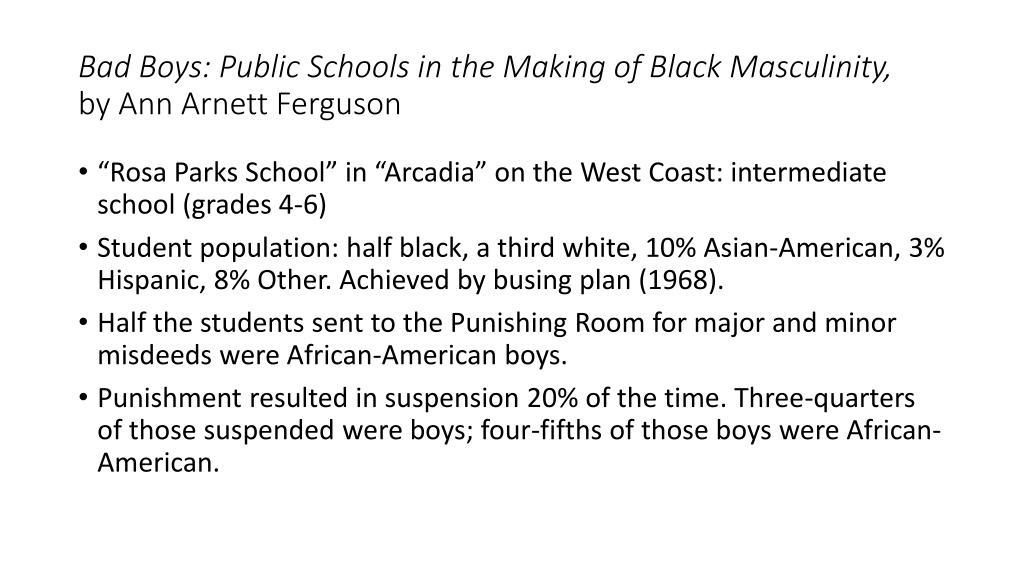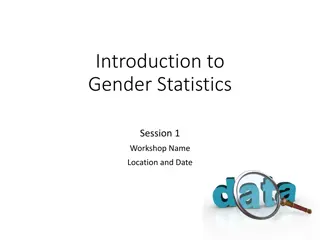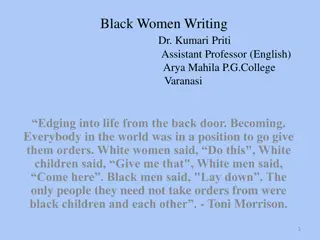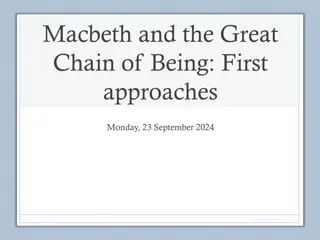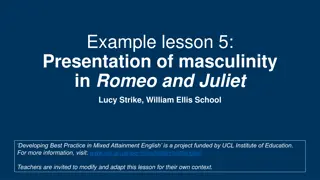Challenges in Public Schools: Black Masculinity, Gender Performance, and School Policies
Ann Arnett Ferguson's work explores the intersection of race, gender, and education, highlighting disparities in discipline faced by black boys in public schools. The role of schools in shaping masculinity and gender identities is questioned, with suggestions for policy changes to address these issues. Judith Butler's theory on gender as performance and a real-life case of agender identity further contribute to the discourse on social structures and individual agency in identity formation.
Uploaded on Sep 27, 2024 | 0 Views
Download Presentation

Please find below an Image/Link to download the presentation.
The content on the website is provided AS IS for your information and personal use only. It may not be sold, licensed, or shared on other websites without obtaining consent from the author. Download presentation by click this link. If you encounter any issues during the download, it is possible that the publisher has removed the file from their server.
E N D
Presentation Transcript
Bad Boys: Public Schools in the Making of Black Masculinity, by Ann Arnett Ferguson Rosa Parks School in Arcadia on the West Coast: intermediate school (grades 4-6) Student population: half black, a third white, 10% Asian-American, 3% Hispanic, 8% Other. Achieved by busing plan (1968). Half the students sent to the Punishing Room for major and minor misdeeds were African-American boys. Punishment resulted in suspension 20% of the time. Three-quarters of those suspended were boys; four-fifths of those boys were African- American.
U.S. Department of Education, Civil Rights Office (March 2014) Black students represent 16% of student population, but 32- 42% of students expelled or suspended White students represent 51% of student population, and 32- 42% of students expelled or suspended 20% of black boys were suspended; 12% of black girls; much higher than their peers
What is Arnett Fergusons argument for why this is happening?
Judith Butlers theory of gender as performance, pp. 170-171 Identification of sex difference happens with identification of genitalia at birth Gender identification happens through routine, ongoing gender performance drawing on well-used scripts and scenarios How do we signal our gender identity to others? How do we know others gender identity? The enactment of sex difference. . . is a compulsory requirement of social life (Arnett Ferguson 2001, p. 171). Do you agree or disagree? Coercion/freedom not so different? Perhaps we are coerced into gender identification but also find it as a site of freedom and self-making
The Fire on the 57 Bus in Oakland, New York Times, January 29, 2015 Sasha Fleischman, age 18, identifies as agender, neither male nor female On way home from school, wearing a skirt, and fell asleep
What is the role of school in the boys performance of masculinity? What are the long-term consequences of being a Troublemaker? What recommendations might you make to schools to change this?
